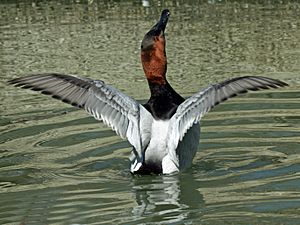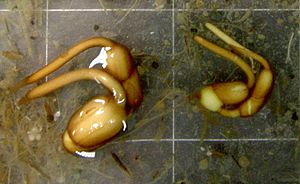Canvasback facts for kids
Quick facts for kids Canvasback |
|
|---|---|
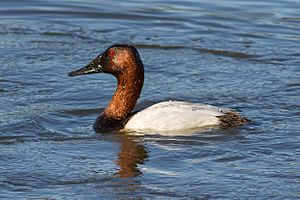 |
|
| Male | |
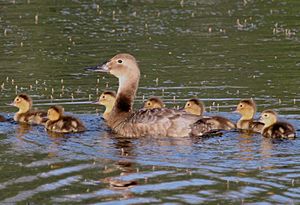 |
|
| Female with ducklings | |
| Conservation status | |
| Scientific classification | |
| Genus: |
Aythya
|
| Species: |
valisineria
|
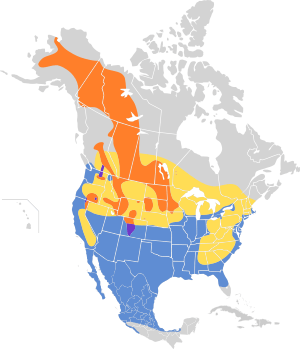 |
|
| Synonyms | |
|
Aythya vallisneria (lapsus) |
|
The canvasback (Aythya valisineria) is a type of diving duck. It's the biggest diving duck you can find in North America. These ducks are known for their unique wedge-shaped heads and long necks. They are strong swimmers and divers, often found in wetlands and bays.
Contents
Understanding the Canvasback's Name
How the Canvasback Got Its Scientific Name
A Scottish-American scientist named Alexander Wilson first described the canvasback in 1814. The duck's scientific name, Aythya valisineria, has interesting roots.
The first part, Aythya, comes from an old Greek word. It was used to describe an unknown seabird by ancient writers like Aristotle.
The second part, valisineria, comes from a plant called wild celery (Vallisneria americana). This plant is a favorite food for canvasbacks when they are not breeding. The celery plant itself was named after an Italian botanist, Antonio Vallisneri.
Why Is It Called a Canvasback?
The common name "canvasback" came from early European settlers in North America. They thought the duck's back looked like the color and texture of canvas fabric.
In other languages, its name often means "white-backed duck." For example, in French, it's morillon à dos blanc. In Spanish, it's pato lomo blanco. In Mexico, it's sometimes called pato coacoxtle.
What Does a Canvasback Look Like?
Canvasbacks are large ducks. They are usually about 48 to 56 centimeters (19 to 22 inches) long. They can weigh between 862 and 1600 grams (1.9 to 3.5 pounds). Their wingspan is about 79 to 89 centimeters (31 to 35 inches).
They are the largest ducks in their group, Aythya. They are similar in size to a mallard but have a stronger, more compact body.
Male Canvasbacks (Drakes)
Adult male canvasbacks, called drakes, have a black bill. Their head and neck are a rich chestnut red. They have a black chest, a grayish back, and a blackish-brown tail.
The sides, back, and belly of the drake are white. They have fine, wavy lines that look like the weave of canvas. This is how they got their name! Their legs and feet are bluish-gray. In spring, their eyes are bright red, but they look duller in winter.
Female Canvasbacks (Hens)
Adult female canvasbacks, called hens, also have a black bill. Their head and neck are light brown, fading into a darker brown chest. Their sides, flanks, and back are grayish-brown. Like the males, their legs and feet are bluish-gray.
Both males and females have a unique sloping profile. This helps tell them apart from other ducks.
Where Do Canvasbacks Breed?
Canvasbacks breed in the prairie potholes of North America. These are wetlands with many small ponds. They build large nests from plants in a marsh. They line their nests with soft down feathers.
They usually find a new mate each year. They pair up in late winter in ocean bays. Canvasbacks prefer to nest over water in permanent prairie marshes. They like areas surrounded by tall plants like cattails and bulrushes. These plants offer good protection.
Other important breeding spots include river deltas in Saskatchewan and Alaska.
Canvasback Eggs and Chicks
A female canvasback usually lays about 5 to 11 greenish-drab eggs. When the chicks hatch, they are covered in soft down. They can leave the nest very soon after hatching.
Sometimes, canvasbacks lay their eggs in other canvasback nests. Also, redhead ducks often lay their eggs in canvasback nests. This is a type of behavior called brood parasitism.
How Canvasbacks Migrate
Canvasbacks travel long distances. They use two main routes, called flyways. One is the Mississippi Flyway, which takes them to wintering areas in the eastern and central United States. The other is the Pacific Flyway, which leads them to wintering spots along the coast of California.
Historically, most canvasbacks spent winter in the Chesapeake Bay. However, much of the underwater plant life there has disappeared. Because of this, many ducks have moved south to other areas.
They like to spend winter in brackish (slightly salty) estuaries and marshes. These places have lots of underwater plants and small invertebrates (animals without backbones).
Some canvasbacks have even flown across the Atlantic Ocean! Several have been seen in the United Kingdom.
What Do Canvasbacks Eat?
Canvasbacks mainly find food by diving underwater. They sometimes dabble (tip their heads into the water) too. Their diet includes seeds, buds, leaves, and roots. They also eat snails and insect larvae.
Their favorite food is wild celery, which is part of their scientific name. They also really like the tubers (underground stems) of sago pondweed. Sometimes, this plant makes up all of their diet.
Canvasbacks have large webbed feet, which are perfect for diving. Their bills help them dig tubers out of the mud at the bottom of the water.
Changes in Their Diet Over Time
In the late 1930s, studies showed that about 80% of what canvasbacks ate was plants. By the early 1950s, about 225,000 canvasbacks spent winter in the Chesapeake Bay. This was half of all the canvasbacks in North America!
But by 1985, only 50,000 ducks were wintering there. This was due to a big drop in underwater plant life. Scientists found that the ducks had changed their diet. By the 1970s, about 80% of their food was Baltic Clams. These clams are very common in the Chesapeake Bay.
Canvasbacks are omnivores, meaning they eat both plants and animals. During breeding season, they eat both. But during migration and winter, they mostly eat roots and tubers from water plants. They can dive straight down to about 2 meters (7 feet) to get these plants. They also eat food from or just below the water's surface.
Canvasbacks and Conservation
The number of canvasbacks has changed a lot over the years. In the 1980s, their numbers were low. This put them on lists of animals needing special attention. But their numbers grew a lot in the 1990s.
Canvasbacks are especially at risk from droughts and the draining of wetlands. These changes happen in the prairies of North America where they live.
Many duck species, including the canvasback, travel long distances. Protecting their nesting places is very important. Even if they are hunted in other areas, keeping their breeding grounds safe helps them survive. Protecting key feeding and breeding areas is vital for many types of migratory birds.
See also
 In Spanish: Porrón coacoxtle para niños
In Spanish: Porrón coacoxtle para niños



